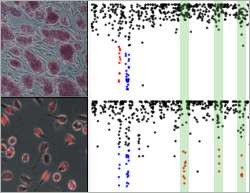Novel epigenetic patterns involved in cell fate regulation

(PhysOrg.com) -- Scientists from the Friedrich Miescher Institute for Biomedical Research (FMI) publish exciting new results on the regulation of cell fate in the scientific journal Nature. They identified novel epigenetic patterns that are generated dynamically by transcription factors depending on the cell type and stage of development. The identification of these epigenetic "fingerprints" allows conclusions about the history and the fate of the cells and should also aid in understanding the processes that lead to diseases such as cancer.
A chip of paint, a fingerprint or a fiber left behind... clues barely discernible to the eye help us to draw conclusions about the sequence of events in a crime. On a similar search for clues as to how the vast number of our genes is regulated, researchers from the Friedrich Miescher Institute for Biomedical Research (FMI) and the Novartis Institutes for BioMedical Research have now discovered that proteins that bind to DNA leave specific molecular fingerprints behind. As they report today in the renowned journal Nature, using a highly sensitive method, they discovered that transcription factors manipulate epigenetic markings on the DNA in a targeted fashion. These molecular clues aid in understanding how genes are regulated.
To accomplish this, epigeneticists in the laboratory of Dirk Schübeler, Group Leader at the FMI and Professor at the University of Basel, and bioinformaticians in the Computational Biology Unit headed by Michael Stadler compared the methylation patterns of stem cells with those of neuronal progenitors. In doing so, they found regions on the DNA that bear particularly few methyl groups. These so-called LMRs (low methylated regions) vary from one cell type to another. They are located in the regions of the genes that control transcription and thus cell fate. Further analysis showed that transcription factors contribute to the emergence of the LMR pattern in a targeted manner. Without the action of the transcription factors, the DNA remains methylated and compactly packaged. Moreover, the LMRs are dynamic and change depending on the developmental stage of the cell.
"These results represent a paradigm shift," comments Schübeler. "The direct connection we observed between transcription factors and DNA methylation places greater emphasis again on transcription factors in controlling cell fate."
But the results also have important practical applications. "There is a worldwide effort to decode the epigenome of various types of cancer. Our results now show that the data collected from these projects also enable the reconstruction of the processes that led to cancer," says Schübeler. "In this way, we can relatively simply and reliably identify the cell processes and proteins that have gone awry."
More information: Stadler MB, Murr R, Burger L, Ivanek R, Lienert F, Schöler A, Wirbelauer C, Oakeley EJ, Gaidatzis D, Tiwari VK, Schübeler D. (2011) DNA-binding factors shape the mouse methylome at distal regulatory regions. Nature, doi:10.1038/nature10716
Journal information: Nature
Provided by Friedrich Miescher Institute for Biomedical Research
















